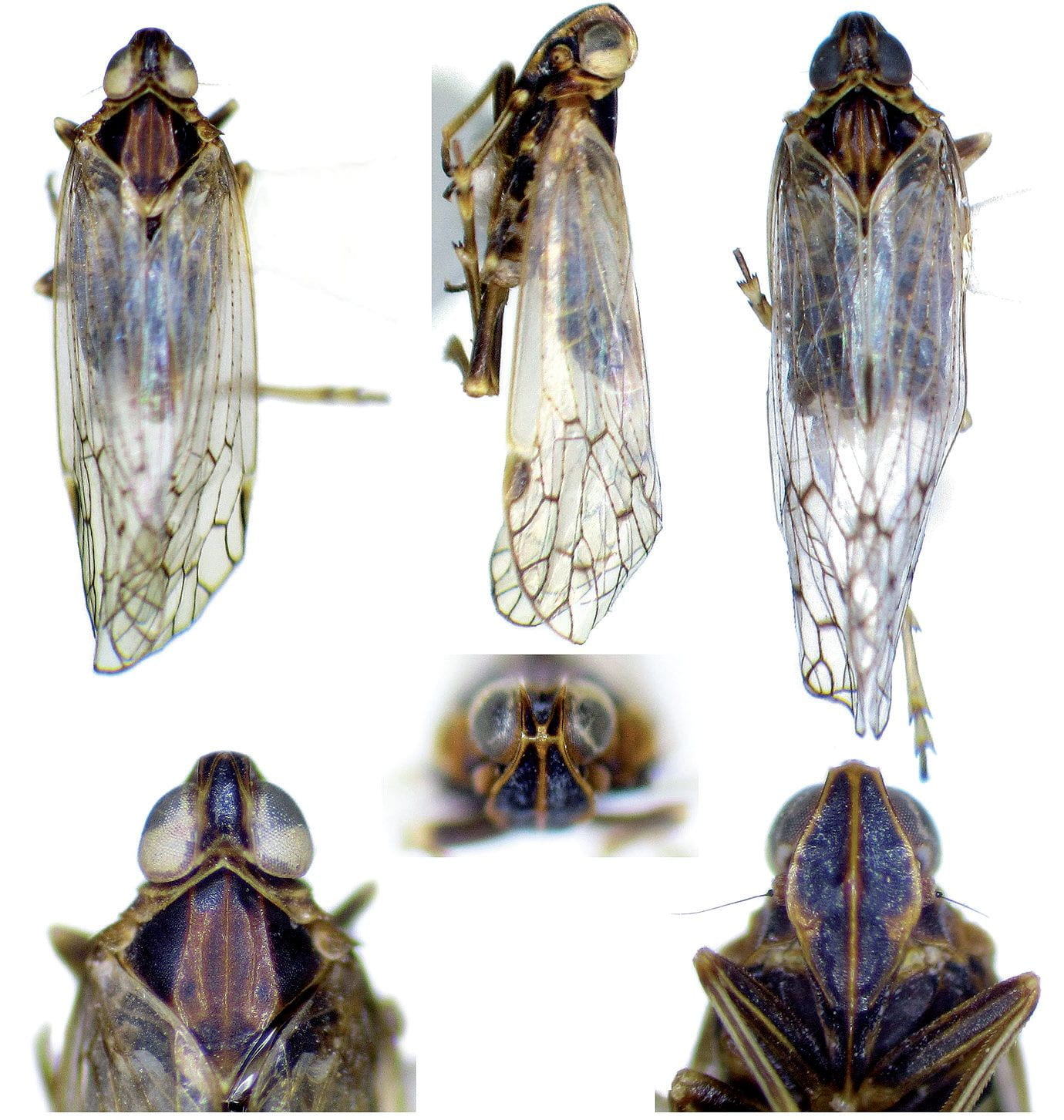[Back to North American Cixiidae]
Contents
Family Cixiidae Spinola, 1839
Subfamily Cixiinae Spinola, 1839
Tribe Pentastirini Emeljanov, 1971
Genus: Amiarus Hendrix & Bartlett, 2025
Type species Oliarus kindli Bourgoin, Wilson & Couturier, 1998.
Distribution
Widespread – Canada to Argentina
Recognized species
Subgenus Amiarus Hendrix & Bartlett, 2025
1. Amiarus (Amiarus) deserticola Campodonico, 2018: Chile (Tamarugal).
2. Amiarus (Amiarus) dimidiatus (Berg, 1879): Argentina (Buenos Aires, Corrientes, Entre Rios).
3. Amiarus (Amiarus) fulvus (Walker, 1858): Brazil (Pará).
4. Amiarus (Amiarus) kindli (Bourgoin, Wilson & Couturier, 1998), new combination: Brazil; French Guiana (Corréze); Trinidad and Tobago (Trinidad).
5. Amiarus (Amiarus) oryzicola (Bourgoin, Wilson & Couturier, 1998): Peru (Loreto).
Subgenus Umbrarus Hendrix & Bartlett, 2025
Type species Flata humilis Say, 1830.
6. Amiarus (Umbrarus) humilis (Say, 1830): Canada (AB, BC, MB, NB, ON, QC, SK); USA (AL, AZ, CT, DC, DE, GA, IA, IL, KS, MA, MD, MI, MN, MS, MT, NC, NE, NH, NJ, NM, NV, NY, OH, OR, PA, SC, TN, UT, WI).
Economic Importance
Not reported as pests,
Plant associations
Nymphs of cixiids are subterranean, feeding on roots and possibly fungi. The significance of adult host records is unclear. Many cixiids are presumed to be polyphagous (as adults), most often on woody plants.
Amiarus (Amiarus) deserticola – Escallonia angustifolia C. Presl (a ‘redclaw’; Escalloniaceae) (Campodonico, 2018)
Amiarus (Amiarus) kindli – Undetermined grasses (Poaceae) (Myrie et al. 2023)
Amiarus (Amiarus) oryzicola – Oryza sativa L. (Poaceae) (Bourgoin & Wilson 1998: 111)
Amiarus (Umbrarus) humilis – “Low pasture,” “tamarack bog,” Juniperus sp. (as juniper; Cupressaceae), “prairie,” “cat-tail bog,” Secale cereale L. (as rye; Poaceae), Poa pratensis L. (Poaceae), Carya sp. (as hickory; Juglandaceae), Asimina sp. (Annonaceae), Medicago sativa L. (as alfalfa; Fabaceae) (Mead & Kramer 1982); coastal grasses (Hendrix & Bartlett, 2025).
Recognition
Medium-sized (~5–6 mm); light brown to black. Head in lateral view with acute apex. Face narrow, maculae of frons reduced or absent; frontoclypeal suture angulate (defining triangular area). Mesonotal carinae orange to concolorous with mesonotum. Wing veins pale, tubercles concolorous; CuP without tubercles; wings generally unmarked or marked with transverse dark pigmentation at anterior and basal thirds of tegmina. Male pygofer with medioventral process small and elongate; acuminate to triangular. Periandrium with three conspicuous elongate ventral processes. Endosoma narrow and apically lobed (bearing 1–2 subapical processes). Anal tube somewhat bilaterally asymmetrical in dorsal aspect; with prominent ridge surrounding epiproct and paraproct in lateral view.
A key to genus is in Hendrix & Bartlett (2025). North American species can be keyed out by Mead & Kramer (1982)

Amiarus (Amiarus), uncertain species (A-D from Mexico, E from Costa Rica)

Melanoliarus (Umbrarus) humilis from Idaho
Online resources
Collecting
Pentastirini are most readily collected at lights; specimens may also be found by beating or vacuum sampling woody vegetation.
Molecular resources
Barcode of Life Database appears to not have data of any Amiarus species.
Selected references
Bartlett, C.R., L.B. O’Brien & S.W. Wilson. 2014. A review of the planthoppers (Hemiptera: Fulgoroidea) of the United States. Memoirs of the American Entomological Society 50: 1–287.
Berg, C. 1879. Hemiptera Argentina (Continuacion). Anales de la Sociedad Cientifica Argentina 8: 178–192.
Bourgoin, T. & M.R. Wilson. 1998. Description of two new species of South American Oliarus Stål (Homoptera: Fulgoromorpha: Cixiidae), including a rice-associated species from Peru. Proceedings of the Entomological Society of Washington 100(1): 108–113.
Campodonico, J.F. 2018. Nueva especie de Melanoliarus Fennah (Hemiptera Cixiidae) del extremo norte de Chile. Revista Chilena de Entomologia 44(1): 23–28.
Hendrix, S.V. & C.R. Bartlett. 2025. Reclassification of the planthopper genus Melanoliarus Fennah, 1945 (Hemiptera: Fulgoromorpha: Cixiidae), primarily north of Mexico, with notes on American Pentastirini. Zootaxa, 5619(1), 1–87. https://doi.org/10.11646/zootaxa.5619.1.1
Hoch, H. 2005. On the identity of the type species of the planthopper genus Oliarus Stål, 1862, Oliarus walkeri (Stål, 1859) (Hemiptera: Cixiidae). Zootaxa 1056: 53–60.
Holzinger, W.E., A.F. Emeljanov & I. Kammerlander. 2002. The family Cixiidae Spinola 1839 (Hemiptera: Fulgoromorpha) – a review. Pp. 113-138. In: Holzinger, W. (ed.). Zikaden: Leafhoppers, Planthoppers, and Cicadas (Insecta: Hemiptera: Auchenorrhyncha). Denisia, Volume 4. Oberosterreichisches Landesmuseum, Linz, Austria. 556 pp.
Mead, F.W. & J.P. Kramer. 1982. Taxonomic study of the planthopper genus Oliarus in the United States (Homoptera: Fulgoroidea” Cixiidae). Transactions of the American Entomological Society 107: 381–569.
Metcalf, Z.P. 1936. General Catalogue of the Homoptera. Fascicle IV Fulgoroidea . Part 2 Cixiidae. Smith College, Northhampton, Massachusetts. 269 pp.
Myrie, W., A. Beekham, A. Baksh, J. Parris, F. Shah, C.R. Bartlett, E.E. Helmick, S. Hendrix, & B.W. Bahder. 2023. A new species of planthopper in the genus Melanoliarus (Hemiptera: Auchenorrhyncha: Fulgoroidea: Cixiidae) from coconut palms (Cocos nucifera) in Trinidad. Zootaxa 5271(2):253–270. https://doi.org/10.11646/zootaxa.5271.2.3.
Say, T. 1830a+b. Descriptions of new North American hemipterous insects, belonging to the first family of the section Homoptera of Latreille. Journal of the Academy of Natural Sciences of Philadelphia. 6:235-244, 299–314.
Walker, F. 1858. Supplement. List of the specimens of Homopterous Insects in the collection of the British Museum. Edward Newman, London, 307 pp.
Wilson, S.W., C. Mitter, R.F. Denno & M.R. Wilson.1994. Evolutionary patterns of host plant use by delphacid planthoppers and their relatives. In: R.F. Denno & T.J. Perfect, (eds.). Planthoppers: Their Ecology and Management. Chapman and Hall, New York. Pp. 7–45 & Appendix.




